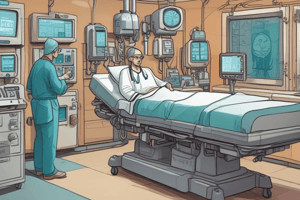Podcast
Questions and Answers
What is the primary purpose of adjunct anesthetics?
What is the primary purpose of adjunct anesthetics?
- To replace general anesthetics
- To complement the use of general anesthetics (correct)
- To reduce the dosage of general anesthetics
- To induce anesthesia
Which of the following is NOT a type of adjunct anesthetic?
Which of the following is NOT a type of adjunct anesthetic?
- Antibiotics (correct)
- Neuromuscular blocking agents
- Sedative hypnotics
- Opioid analgesics
What is the primary effect of general anesthetics on the CNS?
What is the primary effect of general anesthetics on the CNS?
- Alteration of sensory and motor functions
- No effect on sensory and motor functions
- Stimulation of sensory and motor functions
- Reduction of sensory and motor functions (correct)
What is the last system to be affected by general anesthesia?
What is the last system to be affected by general anesthesia?
What is a rare but potentially fatal complication of general anesthesia?
What is a rare but potentially fatal complication of general anesthesia?
What is the treatment for malignant hyperthermia?
What is the treatment for malignant hyperthermia?
What are two factors that influence the dose of an anesthetic?
What are two factors that influence the dose of an anesthetic?
What is a characteristic of all general anesthetics in terms of pharmacokinetics?
What is a characteristic of all general anesthetics in terms of pharmacokinetics?
Which system is commonly affected by the adverse effects of general anesthetics?
Which system is commonly affected by the adverse effects of general anesthetics?
What is a benefit of Sevoflurane in outpatient surgery settings?
What is a benefit of Sevoflurane in outpatient surgery settings?
What is a characteristic of Ketamine?
What is a characteristic of Ketamine?
What is Propofol commonly used for?
What is Propofol commonly used for?
What is the primary effect of local anesthetics?
What is the primary effect of local anesthetics?
When are local anesthetics commonly used?
When are local anesthetics commonly used?
What is an adverse effect of Ketamine?
What is an adverse effect of Ketamine?
What is Isoflurane similar to?
What is Isoflurane similar to?
What type of anesthesia involves injection of anesthetic into the subarachnoid space?
What type of anesthesia involves injection of anesthetic into the subarachnoid space?
What is the main mechanism of action of local anesthetics?
What is the main mechanism of action of local anesthetics?
What is the name of the local anesthetic that is available in several strengths and is used for both infiltration and nerve block anesthesia?
What is the name of the local anesthetic that is available in several strengths and is used for both infiltration and nerve block anesthesia?
What is the main purpose of topical anesthesia?
What is the main purpose of topical anesthesia?
What is the potential systemic effect of local anesthetics on the body?
What is the potential systemic effect of local anesthetics on the body?
What is the term for the injection of anesthetic solution into the tissue that surrounds the operative site?
What is the term for the injection of anesthetic solution into the tissue that surrounds the operative site?
What is the other medical use of parenteral lidocaine besides anesthesia?
What is the other medical use of parenteral lidocaine besides anesthesia?
What is the term for the injection of anesthetic solution at the site where the nerve innervates a specific area?
What is the term for the injection of anesthetic solution at the site where the nerve innervates a specific area?
What is the main effect of Neuromuscular Blocking Drugs (NMBDs) on skeletal and smooth muscles?
What is the main effect of Neuromuscular Blocking Drugs (NMBDs) on skeletal and smooth muscles?
Why is mechanical ventilation required when using NMBDs?
Why is mechanical ventilation required when using NMBDs?
What is the mechanism of action of depolarizing NMBDs?
What is the mechanism of action of depolarizing NMBDs?
What is the main use of NMBDs in surgical procedures?
What is the main use of NMBDs in surgical procedures?
Which of the following NMBDs is a short-acting nondepolarizing drug?
Which of the following NMBDs is a short-acting nondepolarizing drug?
What is a common adverse effect of NMBDs due to the release of histamine?
What is a common adverse effect of NMBDs due to the release of histamine?
Why does succinylcholine cause flaccid muscle paralysis?
Why does succinylcholine cause flaccid muscle paralysis?
Which of the following NMBDs is most commonly used for long surgical procedures?
Which of the following NMBDs is most commonly used for long surgical procedures?
What is the primary purpose of Vancuronium in surgical settings?
What is the primary purpose of Vancuronium in surgical settings?
What is a crucial aspect of nursing assessment during the preoperative phase?
What is a crucial aspect of nursing assessment during the preoperative phase?
What is a potential complication of prolonged use of Vancuronium in the ICU setting?
What is a potential complication of prolonged use of Vancuronium in the ICU setting?
What is an important aspect of patient care during the postoperative phase?
What is an important aspect of patient care during the postoperative phase?
What is a vital sign that should be monitored during the preoperative, intraoperative, and postoperative phases?
What is a vital sign that should be monitored during the preoperative, intraoperative, and postoperative phases?
What is an important teaching point for patients during the postoperative phase?
What is an important teaching point for patients during the postoperative phase?
Flashcards are hidden until you start studying
Study Notes
Anesthesia and Adjuncts
- Anesthesia is used to facilitate endotracheal intubation and provide skeletal muscle relaxation during surgery or mechanical ventilation.
- Adjuncts are "helper drugs" that complement the use of general anesthetics for anesthesia induction, sedation, reduction of anxiety, and amnesia.
Neuromuscular Blocking Agents (NMBDs)
- NMBDs prevent nerve transmission in skeletal and smooth muscles, leading to paralysis.
- They are used as adjuncts with general anesthetics and require mechanical ventilation to prevent brain damage or death by suffocation.
- NMBDs are classified into two groups based on mechanism of action: depolarizing and nondepolarizing.
Depolarizing NMBDs
- Succinylcholine is a depolarizing NMBD that is metabolized slowly, causing flaccid muscle paralysis.
- It is used to facilitate endotracheal intubation due to its quick onset of action (less than 1 minute).
Nondepolarizing NMBDs
- Examples include atracurium, rocuronium, vecuronium, and pancuronium.
- They are competitive antagonists of acetylcholine and are classified as short-acting, intermediate-acting, or long-acting based on their duration of action.
General Anesthetics
- Isoflurane is a fluorinated ether with a rapid onset of action, minimal cardiovascular depression, and low toxicity.
- Sevoflurane is the newest fluorinated ether, with rapid onset and elimination, making it useful for outpatient surgery.
- Ketamine is used for general anesthesia and moderate sedation, with a rapid onset of action and low incidence of cardiovascular and respiratory depression.
- Propofol is a parenteral general anesthetic used for induction and maintenance of general anesthesia, as well as sedation for mechanical ventilation in ICU settings.
Local Anesthesia (Regional Anesthetics)
- Local anesthetics reduce pain sensations at the level of peripheral nerves, blocking nerve conduction in specific areas of the body.
- They are used in clinical settings where loss of consciousness is undesirable or unnecessary, such as childbirth, dental procedures, and diagnostic procedures.
Types of Local Anesthesia
- Central: spinal or intraspinal anesthesia, including intrathecal and epidural anesthesia.
- Peripheral: infiltration, nerve block, and topical anesthesia.
Mechanism of Action and Adverse Effects of Local Anesthetics
- Local anesthetics work by interfering with nerve transmission in a specific area, blocking the generation and conduction of impulses.
- Systemic adverse effects depend on the administration site and dosage, and may affect circulatory and respiratory functions.
Studying That Suits You
Use AI to generate personalized quizzes and flashcards to suit your learning preferences.




